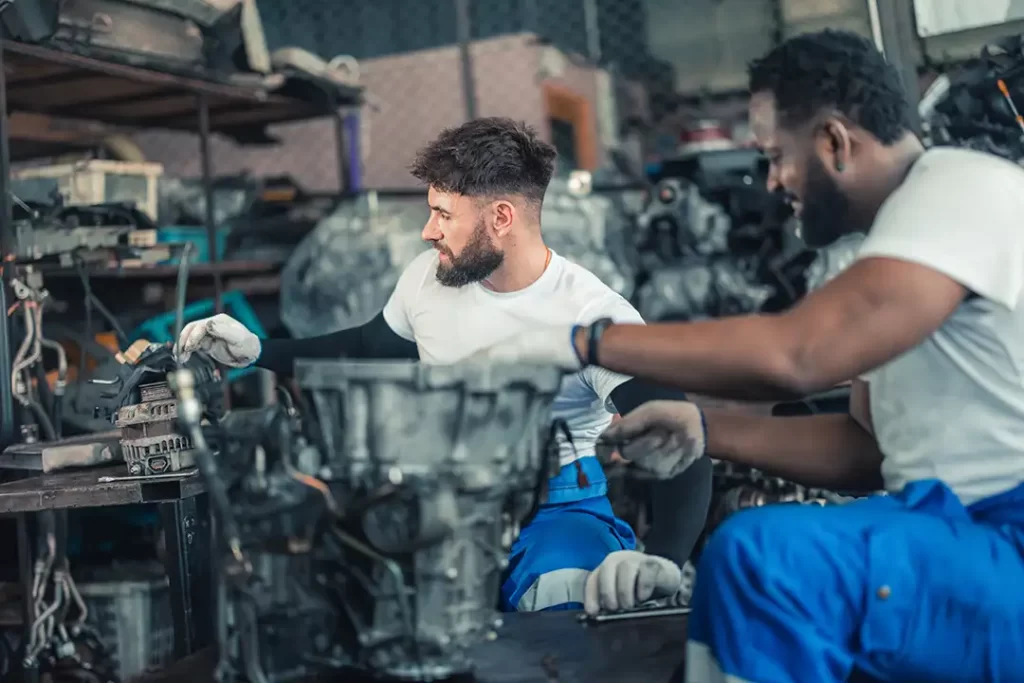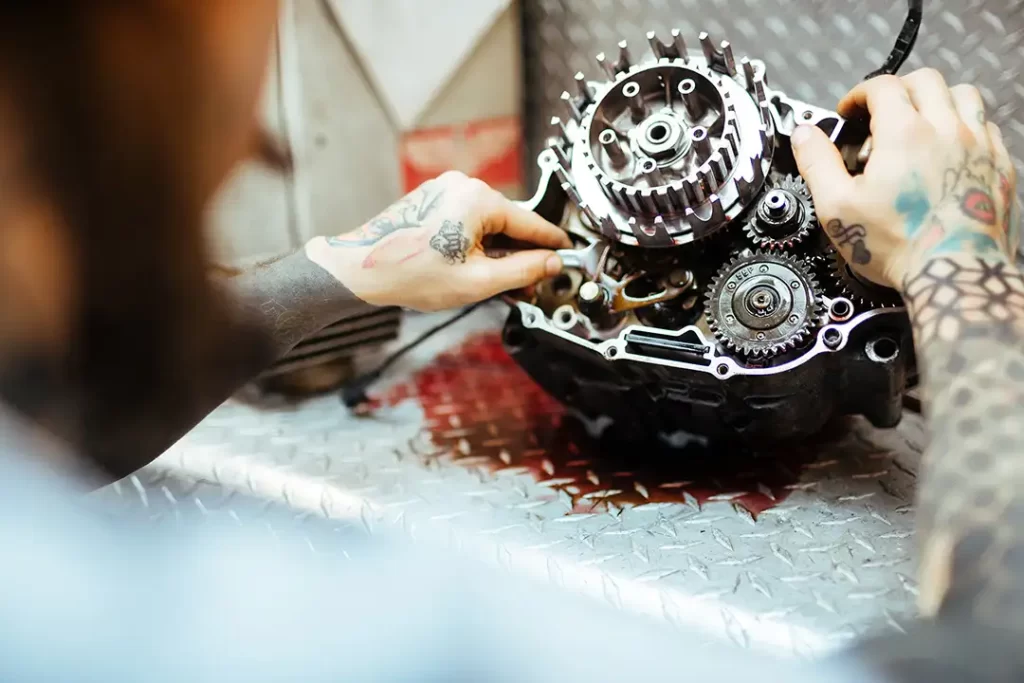The transmission is one of the most important components of the car, which is extremely important for its proper operation. In fact, it is the transmission that transmits torque from the car engine to its chassis. It is not surprising that manufacturers pay special attention to this mechanism, trying to make it as reliable as possible, so malfunctions in the boxes occur quite rarely – of course, with reasonable and correct operation.
Manual gearboxes are a fairly simple (among other boxes) and very reliable mechanism, problems with automatic transmissions are slightly more common. However, any mechanism wears out as a result of operation and begins to work worse, some malfunctions may occur. Therefore, it is necessary to perform timely maintenance and timely repair of the car transmission in order to avoid complete failure of this mechanism.
What is transmission
A car’s transmission is a set of various units and mechanisms that transmit torque from the engine to the drive wheels and change its magnitude and direction. In other words, it is the transmission that allows the car to start moving, accelerate and move, including in reverse.
Its design is closely related to the original layout of the vehicle, i.e. how the engine and drive wheels are positioned relative to each other. In front-wheel drive cars, the engine and transmission are essentially a single unit under the hood. In a rear-wheel drive layout, the engine is in the front and the drive wheels are in the rear. There are also more exotic options, such as a central and rear-engine layout.
Additionally, the transmission becomes more complicated if there is a four-wheel drive. In this case, four wheels will be driving, and there are some nuances here – in what ratio the power is distributed across the axles, the type of locking, etc. In addition, there are specific transmissions that either have not found widespread use or are used in heavy construction, agricultural and military equipment.
Main Mechanisms of transmission
The first thing you need to understand, at least in general terms, is what the transmission of your car consists of. It includes mechanisms such as:
- Gearbox;
- Clutch;
- Transfer case and cardan transmission;
- Front and rear axle;
- Differential;
- Drive shafts.
Transmission maintenance can prevent various malfunctions and complex problems, which usually involves diagnostics of all these components. If you do not do periodic maintenance, the transmission may fail, and subsequent repairs will cost quite a lot of money.
Purpose of transmission
The main purpose of the transmission is to convert and transmit torque. Its design and the characteristics of individual units also determine:
- Dynamics and controllability indicators;
- Safety;
- Efficient fuel consumption. The coordinated operation of all transmission elements ensures the highest possible efficiency with minimal loss of power;
- Transfers engine power to the wheels efficiently;
- Enables the vehicle to move forward and backward;
- Allows the engine to operate within an optimal RPM range;
- Provides multiple gear ratios for different driving conditions;
- Improves fuel efficiency by matching engine output to speed;
- Helps manage torque output to the drive wheels;
- Supports smooth acceleration and deceleration;
- Prevents engine overload or stalling during operation;
- Enhances overall vehicle performance and drivability.
Transmission device
The transmission design varies depending on the drive type and layout, but in general terms its main components include:
- Manual Transmission
- Automatic Transmission
- Continuously Variable Transmission (CVT)
- Semi-Automatic Transmission
- Dual-Clutch Transmission (DCT)
- Planetary Gear Transmission
- Torque Converter
- Clutch
- Gearbox
- Drive Shaft
- Differential
- Chain Drive
- Belt Drive
- Hydrostatic Transmission
- Epicyclic Gear Train
Signs Of transmission Malfunctions
It is not necessary to perform diagnostics of the car transmission to understand that there is a problem! Some symptoms can be noticed even by a person who is far from understanding the design and operating principle of the units and angles of the car. Here are just some of the most characteristic signs:
- Clutch pedal failures or, on the contrary, too tight movement;
- Clutch slippage with partial engagement or disengagement;
- Extraneous sounds from the gearbox;
- Starting movement with a jerk or noise from the gearbox;
- Problems with gear shifting, requires significant effort;
- Loss of engine power;
- Signals from the on-board computer about faults related to the transmission.

📝 Note:
Any such problem requires a quick response from the driver. Car transmission repair in Lancaster Ave, Dallas, TX will allow us to quickly eliminate the malfunction and return the car to its original performance characteristics and comfort during driving.
Noticing gear shifting issues or strange noises?
How to recognize signs of a faulty transmission of special equipment: advice from professionals
The transmission is one of the most important systems of special equipment. If it is faulty, the machine stops working. Therefore, it is necessary to be able to recognize the signs of a faulty transmission and take measures to quickly restore it. In this section, we will tell you how to determine that the transmission is out of order and what actions you need to take to repair it.
How to recognize that the transmission is faulty
The following signs may indicate a malfunction of the transmission of special equipment. It is worth noting that the presence of at least one of the above signs indicates the need for transmission diagnostics.
⚙️ 1. Problems with gear shifting
The first sign of a bad transmission is difficulty shifting gears. If you feel like your car is shifting differently than usual, it could be a sign of a problem with your transmission. For example, you may have difficulty shifting into a higher gear, or your car may not shift at all.
🔊 2. Noise and vibrations
The second sign of a faulty transmission is noise and vibration when driving. If you hear strange sounds that were not previously present, or your special equipment begins to vibrate when driving, this may be due to problems in the transmission. Do not ignore these signs and be sure to check the transmission.
🐢 3. Loss of power
If your special equipment used to cope with tasks without problems, but now it has difficulty lifting loads or accelerating, most likely the problem is in the transmission. Such a symptom can be associated with both wear of parts and with a violation of the mechanism settings.
💧 4. Oil leaks
The fourth sign of a bad transmission is oil leaks. If you notice oil stains on the ground after your equipment drives over it, this could be a sign of a transmission problem. Oil leaks can occur in a variety of places, including O-rings and gaskets. Either way, it’s important to address the issue quickly to prevent further damage to the transmission.
How to Prevent and Fix Transmission Problems
To prevent problems with the transmission, it is necessary to monitor its condition and undergo regular car maintenance. Also, do not save on high-quality spare parts for special equipment – they ensure reliable operation of the transmission and extend its service life.
If you find any problems with the transmission, you should immediately contact specialists for diagnostics and repair. Self-repair can lead to even more serious problems, and can also lead to unpredictable consequences on the road.
in conclusion
You should note that the transmission is one of the most important systems of special equipment, and its reliable operation is a guarantee of successful work on the road. Therefore, it is necessary to be able to recognize the signs of a faulty transmission and immediately contact a specialized auto shop for its repair.
Following these simple tips, you can extend the service life of the transmission and ensure safety when driving on the road.
Frequently asked questions (FAQs) about transmission repair
Common symptoms of a failing transmission include gear shifting problems, strange noises or vibrations while driving, slipping gears, oil leaks, loss of power, and warning lights on the dashboard. If you notice any of these signs, schedule a transmission check immediately.
A transmission transfers torque from the engine to the drive wheels and controls the speed and direction of the vehicle. It allows the engine to operate efficiently across various speeds and driving conditions using gear ratios.
Transmission issues can result from worn-out components, lack of regular maintenance, overheating, dirty or low transmission fluid, or manufacturing defects. Poor driving habits and ignoring early warning signs can also lead to serious transmission damage.
Prevent transmission problems by scheduling regular maintenance, checking and changing transmission fluid as recommended, using high-quality parts, avoiding aggressive driving, and addressing leaks or gear-shifting issues early.
If the damage is minor, repairing the transmission may be sufficient. However, if there is significant internal wear or failure, a full rebuild or replacement may be more cost-effective. A professional diagnosis is essential to determine the best solution.

